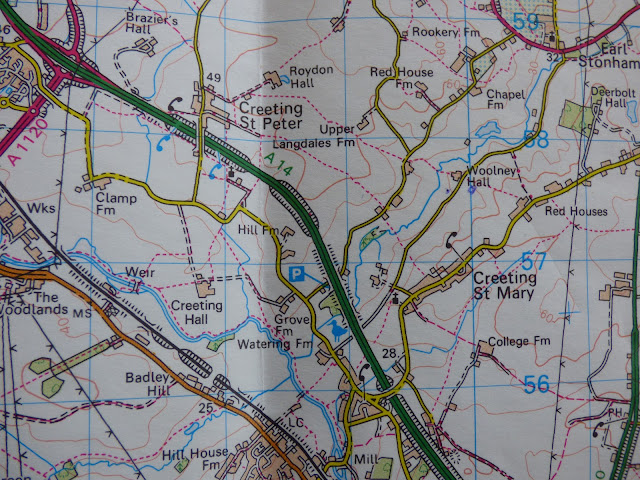There are two churches in the two Creetings which are small villages chopped through by the A14 just to the north of Needham Market. Creeting St Mary and Creeting St Peter .
From geophysical surveys they know this is how the All Saints Church looked with St Marys behind it, sharing a churchyard and below is St Marys as it is now. From "eye witness" accounts from the time All Saints church is thought to have had a round tower.
For nearly 1,000 years the two churches for the two villages stood side by side on this high spot and would have been very visible from the Gipping valley below and were known as "Creeting Two Churches"
In 1800 All Saints suffered badly in a storm after already being slightly dilapidated and permission was given to demolish it in 1801 when it was found to have been built with almost no foundations. An aisle was added to St Marys for the extra congregation.
From the board............
Olaf, King of Norway, fought for Ethelred II in East Anglia against the Danes. He was canonised on his death in 1028 and remains a Norwegian national hero. The Church stood opposite Woolney Hall, the Manor of St Olaves. Held by a freeman named UlnodIn 1066, William the Conquerer gave land to Robert , Earl of Montaigne and the Abbot of Greste established St Olaves (a cell of the Abbey of St Mary de ? in Normandy. St Olaves was sold about 1350 to the De La Pole family, Duke of Suffolk. St Olaves belonged to Henry VIII twice in his reign eventually becoming part of the divorce settlement of Anne of Clevesin 1540 .
The church lasted for a few more years but in 1735 a visitor to the site recorded "Church down, Hath been long down".
Field walking in 1999, geophysics and an excavation of topsoil revealed a part of the East wall and some medieval glass from C14. Now all there is to see from the bank above the road - is a wheat field.





Very interesting, thanks, Sue. The Lost Church sound spooky and mysterious, doesn't it. A good book title.
ReplyDeletexx
It would make a good title -but I wouldn't have a clue where to start
Deletevery interesting your history is so long and deep compared to ours.
ReplyDeleteCathy
a 1000 years in a blink of the eye!
DeleteOh you can bet that I'd want to be digging all over that wheat field.
ReplyDeleteBritish churches are steeped in wonderful history. Lately, I'm watching a wonderful documentary on British Villages and am enjoying this equally well.
ReplyDeleteWe have so much history right under our feet and all around
DeleteIt is a pity that the information boards have deteriorated so much. I doubt they will be replaced and all that history will be lost. Thank you for writing it out for us. Fascinating history.
ReplyDeleteThe council don't even replace signposts on main roads so doubt they will fund the boards. I'm glad I got to read them before they were totally unreadable
DeleteThis is fascinating information Sue! There is a sadness in the thought of a lost church. Maybe someone will be able to redo the information boards and mark the basic location for future generations. I love the never ending depth of your history there!
ReplyDeleteSo much history. I know that in Medieval cities, with no regulation of churches, there were dozens and dozens of them without enough parishioners to keep them all going. So much history in churches. I love your blogs on them.
ReplyDeleteI have been to both those lost churches, there are geocaches there!!
ReplyDeleteThe old history here tends to be lost. Your country holds its history close.
ReplyDeleteWow that's interesting.
ReplyDeleteI think the signs are important. Are there no parish or government authorities responsible for their upkeep?
ReplyDeleteVery interesting, I also wish that some area of the government would repair those signs.
ReplyDeleteGod Bless.
The churchs in England were so interesting to see. I remember driving past them when I was there on Suffolk area for 2 years last century. We visited a few and sad some have disappeared. Thanks for sharing history and photos.
ReplyDeleteBecky L
https://grandmabeckyl.blogspot.com